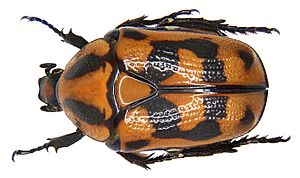Sorghum chafer facts for kids
Quick facts for kids Sorghum chafer |
|
|---|---|
 |
|
| A light colour variety, others are nearly black | |
| Scientific classification | |
| Genus: |
Pachnoda
|
| Species: |
interrupta
|
| Synonyms | |
|
|
The sorghum chafer (scientific name: Pachnoda interrupta) is a type of beetle. It belongs to a family of beetles called Scarabaeidae, which includes dung beetles. People often call it the sorghum chafer because it can be a pest to sorghum plants.
Contents
What Does It Look Like?
The sorghum chafer is a beetle that can grow to be about 11 to 17 millimeters long. That's roughly the size of a small button! These beetles can look very different from each other. Some are a mix of yellow and other colors, while others can be almost completely black.
Where Does It Live?
This beetle is originally from West Africa and North Africa. You can find it in many countries, from Senegal all the way to Egypt. It also lives in the lower areas of northern Ethiopia.
How Does It Behave?
The sorghum chafer is known for eating certain plants. It is a big problem for sorghum crops, especially when the grains are still soft and milky. It also eats pearl millet and maize. Sometimes, these beetles even munch on the flowers of cotton and citrus trees.
These beetles like to lay their eggs and spend the winter in places with rich, damp soil. They prefer shaded areas, like under forest trees or near rivers. Sometimes, there can be a sudden increase in their numbers, which means they might find new places to live and breed.
Mating Habits
Adult sorghum chafers gather together during mating season. This usually happens in July and again in October. They meet up where they find food, like on Acacia trees or on sorghum seeds. Here, they eat and mate.
During mating season, male beetles are only drawn to females who haven't mated yet. This suggests that the female beetles release a special scent, like a perfume, to attract the males. So, when these beetles gather, it's likely because of both the food and these special scents.
Life Cycle
A female sorghum chafer can lay about 1 to 2 eggs each day for about 11 days. The eggs usually hatch into larvae within 4 to 22 days, but on average, it takes about 16 days. The larval stage, where they look like grubs, lasts for about 60 days. After that, they turn into pupae, which is a resting stage, for about 18 days before becoming adult beetles.
The female lays the most eggs during the first four days after mating. She can continue to lay eggs for up to eleven days.
How to Control Them
Scientists have found ways to attract these beetles using special smells. For example, a scent called Methyl salicylate used on cotton plants can attract them. Other scents like eugenol and isoamyl acetate, placed on rubber traps, also work well.
Placing these beetle traps outside the sorghum fields seems to work better than putting them inside the fields. This helps to catch the beetles before they can damage the crops.
See also
 In Spanish: Pachnoda interrupta para niños
In Spanish: Pachnoda interrupta para niños

